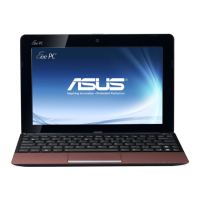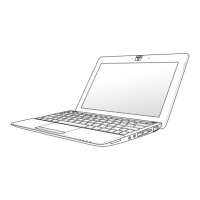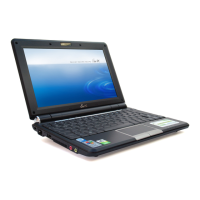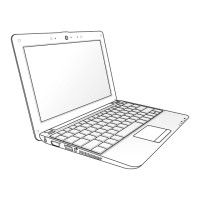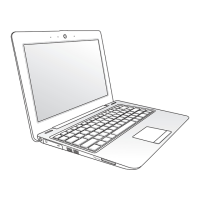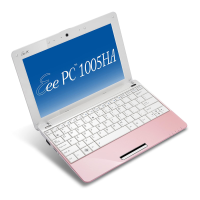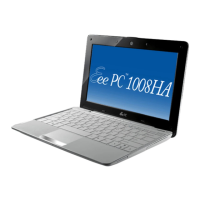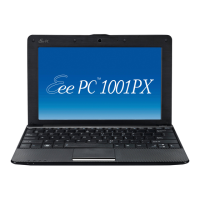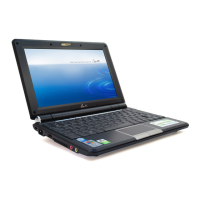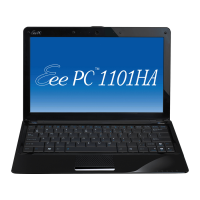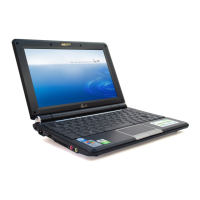Do you have a question about the Asus Eee PC 1011CX and is the answer not in the manual?
Explains the different types of notes and warnings used in the guide for clarity and safety.
Identifies and describes the components located on the top surface of the Eee PC.
Identifies and describes the components located on the bottom surface of the Eee PC.
Identifies and describes the components located on the front edge of the Eee PC.
Identifies and describes the components located on the right edge of the Eee PC.
Identifies and describes the components located on the left edge of the Eee PC.
Explains how to use the keyboard, including special function keys and their commands.
Details how to use the touchpad for various operations like clicking, tapping, dragging, and scrolling.
Provides quick instructions for installing the battery, connecting the adapter, and turning on the Eee PC.
Guides the user through the initial Windows setup process for preferences and basic information.
Explains the use of desktop shortcuts for launching applications and accessing folders.
Details how to configure a wireless network connection by selecting an access point and connecting.
Instructs users on how to use Internet Explorer to surf the web after network setup.
Describes the ASUS Update utility for managing, saving, and updating the Eee PC BIOS.
Provides instructions on how to update the BIOS using the "Easy Flash" utility in the BIOS menu.
Explains how to connect to Bluetooth-enabled devices using the Eee PC's built-in Bluetooth.
Details how to use the Super Hybrid Engine for managing power modes to optimize performance and battery life.
Introduces the Eee Docking tool bar and its useful applications for access, sharing, experience, and tools.
Explains the OS Switch utility for switching between Windows and other fast booting OS versions.
Describes the Instant On feature for zero-wait system restarting and fast resume to the last working state.
Guides the user through the first-time startup and installation of Microsoft Office Starter 2010.
Details how to perform system recovery using the recovery partition (F9 Recovery) during bootup.
Explains how to disable the Boot Booster item in BIOS setup to shorten bootup time or perform system recovery.
Provides FCC statements, RF exposure caution, and other regulatory compliance information.
Outlines the copyright notice and usage restrictions for the manual and its content.
States ASUS's liability limitations regarding product defects, damages, and warranty claims.
Provides contact information and website links for multi-language customer support and service.
Explains the different types of notes and warnings used in the guide for clarity and safety.
Identifies and describes the components located on the top surface of the Eee PC.
Identifies and describes the components located on the bottom surface of the Eee PC.
Identifies and describes the components located on the front edge of the Eee PC.
Identifies and describes the components located on the right edge of the Eee PC.
Identifies and describes the components located on the left edge of the Eee PC.
Explains how to use the keyboard, including special function keys and their commands.
Details how to use the touchpad for various operations like clicking, tapping, dragging, and scrolling.
Provides quick instructions for installing the battery, connecting the adapter, and turning on the Eee PC.
Guides the user through the initial Windows setup process for preferences and basic information.
Explains the use of desktop shortcuts for launching applications and accessing folders.
Details how to configure a wireless network connection by selecting an access point and connecting.
Instructs users on how to use Internet Explorer to surf the web after network setup.
Describes the ASUS Update utility for managing, saving, and updating the Eee PC BIOS.
Provides instructions on how to update the BIOS using the "Easy Flash" utility in the BIOS menu.
Explains how to connect to Bluetooth-enabled devices using the Eee PC's built-in Bluetooth.
Details how to use the Super Hybrid Engine for managing power modes to optimize performance and battery life.
Introduces the Eee Docking tool bar and its useful applications for access, sharing, experience, and tools.
Explains the OS Switch utility for switching between Windows and other fast booting OS versions.
Describes the Instant On feature for zero-wait system restarting and fast resume to the last working state.
Guides the user through the first-time startup and installation of Microsoft Office Starter 2010.
Details how to perform system recovery using the recovery partition (F9 Recovery) during bootup.
Explains how to disable the Boot Booster item in BIOS setup to shorten bootup time or perform system recovery.
Provides FCC statements, RF exposure caution, and other regulatory compliance information.
Outlines the copyright notice and usage restrictions for the manual and its content.
States ASUS's liability limitations regarding product defects, damages, and warranty claims.
Provides contact information and website links for multi-language customer support and service.
| Bus type | DMI |
|---|---|
| Stepping | B3 |
| Processor cache | 1 MB |
| Processor cores | 2 |
| Processor model | N2600 |
| System bus rate | 2.5 GT/s |
| Processor family | Intel Atom® |
| Processor series | Intel Atom N2600 Series |
| Processor socket | BGA 559 |
| Processor threads | 4 |
| Processor codename | Cedarview |
| Processor frequency | 1.6 GHz |
| Processor cache type | L2 |
| Processor lithography | 32 nm |
| Processor manufacturer | Intel |
| Processor front side bus | - MHz |
| Processor operating modes | 64-bit |
| ECC supported by processor | No |
| Thermal Design Power (TDP) | 3.5 W |
| Motherboard chipset | Intel NM10 |
| Memory slots | 1x SO-DIMM |
| Internal memory | 1 GB |
| Memory clock speed | 1333 MHz |
| Memory form factor | SO-DIMM |
| Internal memory type | DDR3-SDRAM |
| Maximum internal memory | 2 GB |
| Memory layout (slots x size) | 1 x 1 GB |
| HDD speed | 5400 RPM |
| HDD capacity | 320 GB |
| Card reader integrated | Yes |
| Compatible memory cards | MMC, SD, SDHC |
| Display surface | Matt |
| Display diagonal | 10.1 \ |
| Display resolution | 1024 x 600 pixels |
| Native aspect ratio | 5:3 |
| Graphics card | GMA 3600 |
| Wireless technology | IEEE 802.11b/g/n |
| Front camera resolution (numeric) | 0.3 MP |
| Bluetooth version | 3.0+HS |
| Cabling technology | 10/100Base-T(X) |
| Networking features | Fast Ethernet |
| Ethernet LAN data rates | 10, 100 Mbit/s |
| Maximum graphics card memory | 0.256 GB |
| On-board graphics card model | - |
| On-board graphics card base frequency | 400 MHz |
| Audio system | HD |
| Product type | Netbook |
| Product color | Black |
| Charging port type | DC-in jack |
| USB 2.0 ports quantity | 3 |
| USB 3.2 Gen 1 (3.1 Gen 1) Type-A ports quantity | 0 |
| Pointing device | Touchpad |
| Battery capacity | 4400 mAh |
| Battery life (max) | - h |
| Number of battery cells | 6 |
| Processor code | SR0W2 |
| Processor ARK ID | 58916 |
| Supported instruction sets | SSE2, SSE3, SSSE3 |
| Depth | 178 mm |
|---|---|
| Width | 262 mm |
| Weight | 1270 g |
| Height (rear) | 36.4 mm |
| Height (front) | 23.6 mm |
